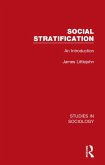Along with the fast growing economy, the term "BRICs" was coined to represent the newly emerging countries, Brazil, Russia, India and China. The enhanced economy in these countries has largely improved people's life; at the same time, it has also strongly influenced the transformation of social structure, norms and values. However, as the world's attention centers on their economic development at the micro level, the social changes at the micro level have often been neglected, and a specific comparative study of these four countries is even more rare. This book, written by the leading sociologists in the four countries, fills the gap in knowledge and examines specifically the changes in each society from the perspective of social stratification, with topics covering the main social classes, the inequality of education and income, the different styles of consumption as well as the class consciousness and values. Under every topic, it gathers articles from authors of each country. Such a comparative study could not only help us achieve better understanding of the economic growth and social development in these countries, but also lead us to unveil the mystery of how these emerging powers with dramatic differences in history, geography, culture, language, religion, etc., could share a common will and take joint action. In general, the book takes a unique perspective to show the readers that it is the profound social structural changes in these countries that determine their future, and to a large extent, will shape the socio-economic landscape of the future world.
Bitte wählen Sie Ihr Anliegen aus.
Rechnungen
Retourenschein anfordern
Bestellstatus
Storno









